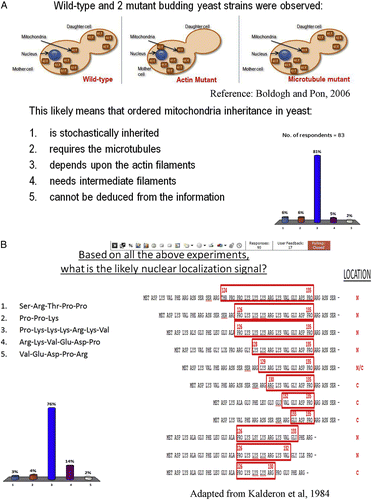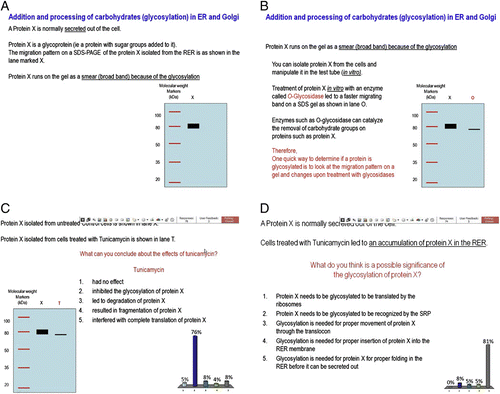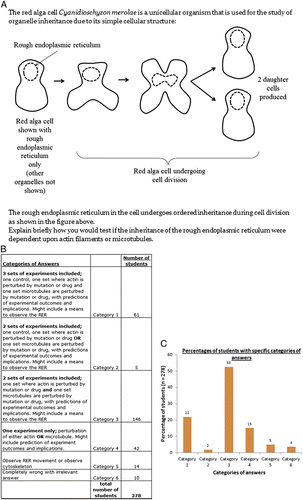Abstract
A surge in the amount of information in the discipline of Cell Biology presents a problem to the teaching of undergraduates under time constraints. In most textbooks and during lectures, students in Singapore are often taught in a dogmatic manner where concepts and ideas are expounded to them. The students in turn passively receive the materials and when they feel overloaded, tend to focus on memorising information for the purpose of assessments. Here, I describe the selective use of published experimental data during my lectures in a southeast Asian university, as an attempt to move away from this common mode of teaching in this region. The use of experimental data to encourage problem-based learning is not new, however, I used this method as a platform to encourage students to derive concepts on their own that would previously have been stated for them. The surveyed undergraduates were deemed very capable of analysing data and drawing appropriate conclusions. It was concluded that by not dictating concepts to these cohorts that the students gained more from generating their ideas themselves, and this added to their training to develop analytical skills.
Introduction
Studying Cell Biology at the undergraduate level provides the foundation for advanced level Life Science modules. However, there has been a deluge of information in this subject area in recent years, as evidenced from the growing number of published articles. For example, a simple search in Science Direct with the term ‘cell cycle’ returned 30 711 articles for the year 2000 and 64 153 for 2011, with number of articles increasing steadily each year between 2000 and 2011. Searches with other terms such as ‘cell signalling’ and ‘organelle biogenesis’ showed similar trends. This growth of information makes it an uphill task to teach Cell Biology comprehensively at an undergraduate level. This is especially the case at the second year level, when the foundations of Cell Biology should be laid in 13 weeks. In our Life Science degree, an advanced level Cell Biology module is offered at the fourth year as an elective. As such, should students not opt for this in their fourth year, they will likely not have another opportunity to formally learn more about Cell Biology. Therefore, the tendency to provide as much information as possible to students in the second year essential module is high.
Dogmatism in Cell Biology
A problem associated with information overload is that the students do not have much time for processing the materials presented to them. Major Cell and Molecular biology textbooks (CitationAlberts et al. 2007, CitationLodish et al. 2007) include molecular basis of cellular structures and functions in excellent details. Coupled with multi-media aids and study guides for student learning, these textbooks are a good resource of knowledge.
For this subject, students are provided with 2 × two-hour lectures each week, and are required to compete two continual assessments and one final written examination. It was apparent that students that studied three or four other similarly heavy modules, coped with the huge quantity of information by memorising facts from textbooks or lecture slides. This was apparent from answers in their assessments where they reproduced parts of the textbooks or lecture slides verbatim, instead of addressing the questions asked.
Several approaches were considered to alleviate this issue. Concept maps (see CitationAllen & Tanner 2003a) have been proposed as being useful for helping students understand relationships between various cellular pathways and reduce memorising. However, the generation of concept maps still requires students to sift through the large volume of information before mapping relationships among the cellular processes. It was also suggested that students be taught in the manner as science is practised (CitationDiCarlo 2006), with problem-based questions as a key strategy to reducing memorising of facts. In such a format, questions are designed to reflect how scientists solve scientific problems and hence, encourage students to think and act in context. While this is deemed a valuable approach, students would still first have to acquire the large chunks of basic knowledge prior to their ‘application’ of the information learnt.
Change in Approach
Perhaps a fundamental issue that teachers have to consider is how to communicate the content of the course to the students. For this study, it was apparent that the key ideas of Cell and Molecular Biology presented in textbooks were laid out as doctrines that students read and were expected to comprehend before applying the knowledge to ‘problems’. In general, during formal lectures, teachers tended to impart the basic concepts by providing the information on a series of presentation slides. In this format, students received the basic knowledge provided in a passive manner (CitationBarr & Tagg 1995), and were then tasked to answer questions based on what they have been taught by ‘application’ of their knowledge during assessments. Textbooks are the core resources for the course but designed to be used for reference purposes, and their format/design makes it difficult to present their information in radically different a manner even with an accompanying multimedia CD.
Therefore, one way to help reduce the problem of such a dogmatic approach in the dissemination of knowledge in Cell Biology is to avoid always explicitly stating facts and concepts. Instead, during appropriate sections of the lectures, students need to be engaged and asked to reason through key datasets to arrive at concepts or theories that would otherwise have been stated for them (CitationWood 2009).
For instance, in a lecture on ‘Organelle Inheritance’ that students mostly have not encountered, a different approach was taken to delivering the key concepts. In the previous years, the idea that ‘the budding yeast requires actin filaments for the inheritance of mitochondria’ (CitationBoldogh & Pon 2006) as a form of ordered organelle inheritance, was stated for the students as a ‘matter of fact’. In a move away from this, the students were provided with a summarised version of the experimental data obtained from primary literature (). Based on the data, the students were then asked to deduce if the budding yeast required actin filaments for the inheritance of mitochondria. Eight-one per cent of the students who responded using the Classroom Response System (TurningPoint, USA; henceforth referred to as the ‘clicker system’) got the answer correct, even though the students had not previously seen the data.
Figure 1 (A) Screen-shot of students’ deduction of the mode of yeast mitochondria inheritance. Of the 82 responders, 81% concluded correctly that the actin filaments are needed. (B) Screen-shot of students’ deduction of the nuclear localisation signal sequence. Of the 98 students who responded, 76% made the correct conclusion as to what is the nuclear localisation signal sequence.

In another example, the general idea of how proteins might be imported into the nucleus was first introduced to students as background knowledge in a traditional dissemination format. Building on this, the case of a specific sequence on the protein needed for nuclear localisation (CitationKalderon et al. 1984) was approached differently from previous years. Instead of directly stating the sequence, the students were shown data from the published article where experimental characterisation of the nuclear localisation sequence (NLS) was conducted (). By examining the data in class, 76% the students were able to arrive at the correct answer. In another instance, students were asked to draw conclusions about the significance of glycosylation during protein trafficking via the secretory pathway (). This was different from previous semesters when they had been told directly that glycosylation of proteins is sometimes needed for export from the rough endoplasmic reticulum. During lectures on cell division, the class was shown data on cell fusion experiments that led to the idea of phase inducers (see ; CitationJohnson & Rao 1970, Rao & Johnson 1970). Over 80% of the students deduced that cell cycle phase inducers are required to drive the cell division cycle ().
Figure 2 (A) Background slide to explain mobility shift in a protein that is glycosylated. (B) Background slide to explain the loss of mobility shift in a glycosylated protein that is treated with O-glycosidase. (C) Screen-shots of students’ responses on the effects of tunicamycin treatment with respect to the glycosylation of proteins. (D) Screen-shots of students’ responses on the significance of glycosylation during protein transport via the secretory pathway; 76% of the students answered correctly and 81% of the students answered correctly.

Figure 3 (A) Screen-shot of students’ answers on the presence of diffusible factors that control S phase of the cell division cycle; 80% of the students answered correctly. (B) Screen-shot of students’ answers on the presence of diffusible factors that control the M phase of the cell division cycle; 90% of the students answered correctly.

The lectures were constructed such that slides showing basic concepts were now used in combinations with ‘data slides’ that encouraged students to synthesize the knowledge themselves. In most cases at least 60% (data not shown) of the students obtained the right answers, indicating that undergraduate students provided the experimental evidence with accompanying background information arrived at the outcomes that historically tutors had stated explicitly for them.
Discussion
Encouraging students to derive concepts in Cell Biology in-class, based on their empirical analysis of data, has led to teaching staff engaging students in higher-order thinking skills than previously, and these skills are likely longer lasting than facts memorised for assessments (CitationCrowe et al. 2008). The module I was teaching was considered locally to be a ‘typical’ Cell Biology module (Appendix 1) and was based on topics covered in Cell and Molecular Biology textbooks (CitationAlberts et al. 2007, CitationLodish et al. 2007). It is suggested that the techniques described here could be applied to Cell Biology modules in general and further afield. Moreover, the clicker questions designed were based primarily on experiments or published articles relevant to the main ideas that are normally taught in Cell Biology modules. Also the clicker systems used to harvest student responses during classes are known to promote active learning in large-classes (CitationAllen & Tanner 2005), and I suggest incorporating challenging questions to encourage students to make their own conclusions (CitationWood 2009) help to dispel the notion of the dogmatic nature of science. This could persuade students that reasoning and synthesis of knowledge (rather than an unthinking acceptance of evidence) are the norm in scientific pursuits. Consequently, students’ tendency to passively accept information should reduce as they become actively engaged in deriving knowledge by themselves.
It should be noted that such an approach meant some sacrifice in terms of time spent on content in favour of promoting analytical skills. For instance, it took 1–2 minutes to set up the questions and, depending on the slides, another 1–2 minutes for students to analyse the data and respond. A follow-up explanation of the answer was then given for each of the question that took another 2–3 minutes depending on the students’ answers. As compared with the previous semesters, the number of slides used (which is related to the information provided to students) had to be reduced by about 20% to 40% across lectures to accommodate such slides.
Given the time spent on this approach in class, there needs to be future evaluation of its efficacy in terms of students’ learning of information that they had synthesised and compare that to information they had been told directly. For example, comparing recall of the sequence of the NLS that they had deduced and the sequence of the classical nuclear export sequence that has been merely shown to them on a slide. Using the clicker systems, such questions could be posed to the students at the beginning of a subsequent lecture as a form of recapitulation of what they had learnt in the previous lecture. A comparison can be made as to whether students recall facts better if they had synthesised them for themselves. If clickers are not available, lecturers could simply ask students for a show of hands, which are the correct options or make use of answer sheets distributed to students that students can write on. Similar questions could also be given to students during the mid-term assessments.
Also there were students who got incorrect answers in class. It could be that these students misinterpreted the questions or had problems with the concepts. As the class was too large for an immediate feedback, an improvement could be to get these students to email me with their questions so I can try to address their difficulties.
Even without follow-up evidence it is clear that this approach enhanced active learning compared to the passive lectures that it replaced. Teaching the process of analysis as opposed to teaching only content also encouraged critical thinking and problem solving at the undergraduate level (CitationLeonard 2000). An interesting outcome of such a mode of teaching was observed at the end of the semester in a ‘closed-book’ examination. Here, students were asked to design a simple experiment to ascertain whether the endoplasmic reticulum inheritance in a red alga cell depends upon actin or microtubules (). The question was aimed to find out if students could understand the methods and basis for conducting specific experiments as shown in –. Six main categories of answers were obtained from the students (). A good percentage of students were able to describe the need to perturb at least either the actin or microtubules (). Yet other students suggested more sophisticated answers that included the need for untreated controls and to perturb separately, actin and microtubules to determine which of the cytoskeletal structures were required. More importantly, most students also predicted possible outcomes of the experiments and from that, how to deduce which of the cytoskeletal structures were needed. This was not directly taught to them during the lectures. While the question was not directly testing content knowledge per se, it nonetheless provided an indication that the students had picked up the implicit lessons pertaining to the process of scientific experimentation and could apply them to the question.
Figure 4 (A) Exam question on how to test the requirement of actin or microtubules for the inheritance of the endoplasmic reticulum in the red algae Cyanidioschyzon merolae. (B) The six categories of answers from students and the number of students giving the various answers. (C) Graph showing percentage of students with the various categories of answers.

These outcomes do not suggest that we abandon more didactic modes of teaching, rather that techniques of this nature should be included in curriculum design where appropriate. Basic information will still be taught in the traditional manner in our curricula, but in a complimentary manner. This study has also catalysed wider exploration of other active learning techniques, such as problem-based learning (CitationAllen & Tanner 2003b, CitationBledsoe 2011) as well as other forms of active-learning activities in large-class settings (CitationAllen & Tanner 2005). Together with traditional lectures, the approach described is focused on equipping students with skills such as critical analysis of data and ability to generate parts of the knowledge for themselves. This is in line with Bloom’s taxonomy for learning (CitationAnderson et al. 2001) and could be combined with other aspects of teaching techniques (CitationCrowe et al. 2008). More significantly, this could help alter students’ mindset that memorising facts is synonymous with learning to think.
References
- Alberts, B. Johnson, A. Lewis, J. Raff, M. Roberts, K. Walter, P. (2007) Molecular Biology of the Cell (5th ed.). Oxford, Garland Science.
- Allen, D. Tanner, K. (2003a) Approaches to cell biology teaching: learning content in context-problem-based learning. CBE – Life Sciences Education 2 (2), 73–81.
- Allen, D. Tanner, K. (2003b) Approaches to cell biology teaching: mapping the journey-concept maps as signposts of developing knowledge structures. Cell Biology Education 2 (3), 133–136. doi: 10.1187/cbe.03-07-0033.
- Allen, D. Tanner, K. (2005) Infusing active learning into the large-enrollment biology class: seven strategies, from the simple to complex. Cell Biology Education 4 (4), 262–268. doi: 10.1187/cbe.05-08-0113.
- Anderson, L.W. Krathwohl, D.R. Bloom, B.S. (2001) A taxonomy for learning, teaching and assessing – a revision of Bloom’s taxonomy of educational objectives. New York, Longman.
- Barr, R.B. Tagg, J. (1995) From teaching to learning – a new paradiagm for undergraduate education. Change 27 (6), 13–25.
- Bledsoe, K.E. (2011) Managing Problem-based Learning in Large Lecture Sections. Bioscience 18, 18-11.
- Boldogh, I.R. Pon, L.A. (2006) Interactions of mitochondria with the actin cytoskeleton. Biochimica et Biophysica Acta 1763 (5–6), 450–462. doi: 10.1016/j.bbamcr.2006.02.014.
- Crowe, A. Dirks, C. Wenderoth, M.P. (2008) Biology in bloom: implementing Bloom’s taxonomy to enhance student learning in biology. CBE – Life Sciences Education 7 (4), 368–381. doi: 10.1187/cbe.08-05-0024.
- DiCarlo, S.E. (2006) Cell Biology should be taught as science is practised. Nature 7, 290–296.
- Johnson, R.T. Rao, P.N. (1970) Mammalian cell fusion: induction of premature chromosome condensation in interphase nuclei. Nature 226 (5247), 717–722.
- Kalderon, D. Roberts, B.L. Richardson, W.D. Smith, A.E. (1984) A short amino acid sequence able to specify nuclear location. Cell 39 (3), 499–09.
- Leonard, W.H. (2000) How do college students best learn science? Journal of College Science Teaching 29, 385–388.
- Lodish, H. Berk, A. Kaiser, C.A. Krieger, M. Scott, M.P. Bretscher, A., et al.. (2007) Molecular Cell Biology, 6th ed. Houndmills, W. H. Freeman.
- Rao, P.N. Johnson, R.T. (1970) Mammalian cell fusion: studies on the regulation of DNA synthesis and mitosis. Nature 225 (5228), 159–164.
- Wood, W.B. (2009) Innovations in teaching undergraduate biology and why we need them. Annual Review of Cell and Developmental Biology 25, 93–112.
Appendix 1:
Timetable for Semester II, 2011/2012 – LSM2103 – Cell Biology
Module coordinator: Dr Yeong Foong May
Email: [email protected]
Tel: 6516-8866